I first became acquainted with feminist art in Kyiv in 2012, when Feminist Ofenzyva (Feminist Offensive) organised ‘Women’s Workshop’, a project which invited female artists to create their works in collaboration with the public.
I was particularly struck by the work of Zhanna Kadyrova. Famous in Ukraine for her enormous sculptures and mosaics occupying up to two floors of a building, Zhanna was sat with a pile of newspapers, cutting out photographs of people with nail scissors for a surreal collage of miniature figures.
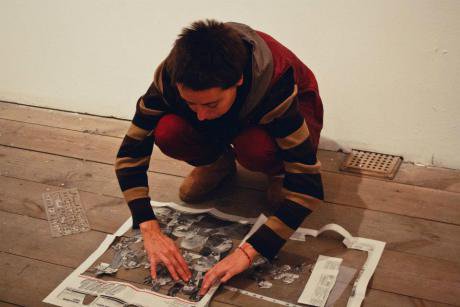
Zhanna Kadyrova in the process of creating her collage, ‘Women’s Workshop’ exhibition, 2012. (c) Karina Sembe.
The newspapers were from various countries, but the world appeared uniform in the collages, as if inhabited only by men in suits doing highly serious things. Only rarely did a woman make an appearance amongst this mass of be-suited males, often with a smile on her face, either elegantly dressed or nude. In an interview with ArtUkraine, Zhanna explained that ‘the discrepancies between images of men and women struck me: for every three images of women, there were a hundred images of men. I then noticed how their roles are depicted. Men are shown shaking hands, women are shown in adverts, in the cultural sphere, or with a baby and that’s all.’
‘There are no other roles for women… Elsewhere in Europe or the US you can sometimes find images of a business woman in front of a microphone who has something to say. But it is rare in our [Eastern European] countries.’
In the mirror-world of patriarchy
The world in Kadyrova’s collage may seem strange, but it reflects the situation of women in contemporary Belarus, Ukraine, and Russia.
The social, political and economic differences between the three countries are considerable, but the patriarchal tendencies found in each are often identical. Many of the issues faced by women have their roots in the Soviet era. It was in the Soviet Union that the idea of the ‘working mother’ took hold: a woman was to work on the same level as men, but was also expected to bring up the children, look after the household and herself. Nowadays, gender equality is proclaimed de jure as a goal rather than given. However, in reality it is not implemented in law, and many experience discrimination.
Many factors contribute to what amounts to the feminisation of poverty in these countries. Women are forbidden from working in a great many professions (almost 200 in Belarus, more than 400 in Russia, and over 500 in Ukraine). There exists a strong vertical and horizontal gender segregation at work, and the pay gap between men and women is large (25-40% depending on the country). Similar to Soviet times, women come home after work and start an unpaid ‘second shift’ of housework: cooking, looking after children and relatives.
While the USSR was far from paradise for women, its legislation had a silver lining: Soviet Russia was the first country in the world to legalise abortions, and, apart from Stalinist times, abortions were free and easily accessible in Ukraine, Russia, and Belarus. Yet in recent years, these states have all tried to restrict women’s reproductive rights under the guise of preventing a demographic crisis. This conservative politics is often initiated on the basis of a return to the traditional values of the hetero-normative family, and women are expected to produce a large quantity of children.
The situation is particularly acute in Belarus. In 2013, a council of ministers severely restricted the possible justifications for an abortion in the later stages of pregnancy: now a woman is only granted an abortion in cases of rape or the previous deprivation of parents’ rights. According to 2014 amendments in legislation, every woman in need of an abortion must first consult with a lawyer and psychologist.
Finally, this March, the Ministry of Health together with the Belarusian Eastern Orthodox Church undertook the ‘innovation’ of the so-called ‘Week without abortions’ (where a week for the Ministry somehow equals 9 working days): each day, abortions are banned in a different region of Belarus.
Men in suits
The Belarusian Eastern Orthodox Church undertook the ‘innovation’ of the so-called week without abortions.
The be-suited men who occupy the vast majority of positions in the Russian government have actively maintained a programme that limits the rights and roles of women in Russia.
The lives of bisexual, lesbian, and transgender women are endangered because of the infamous law banning ‘homosexual propaganda’ adopted in 2013. Despite a petition which gathered over 100,000 signatures, the government has yet to propose a law concerning violence against women.
Representatives of the Eastern Orthodox Church (which maintains substantial links with the Russian government) have actively sought to restrict the use of the term ‘domestic violence.’ Russia is also on the verge of criminalising abortions: a recent legislative initiative proposes a criminal penalty of a year in prison for a woman, her partner, and a doctor who performed an abortion. News of the proposed restrictions on abortions has already provoked a response by Russian feminists. One of the examples is the YouTube campaign ‘A Right to Abortion’ led by Leda Garina of LeftFem. Garina and other feminist activists are now being called for an interview with the Department for Countering Extremism: apparently, defending women’s rights is an extremist activity in Russia.

More than 100 women have taken part in the campaign #PravoNaAbort. Still taken from YouTube.
The Ukrainian government strived to adopt the conservative turn maintained by their Russian and Belarusian counterparts. However, their efforts have met with considerably less success. In 2013, an attempt to outlaw abortion failed. Measures against homosexual ‘propaganda’ were also proposed in 2011 and 2012, but were not ratified into law.
Quite why these measures failed is not clear. It is likely that street protests by leftist, feminist, and LGBT groups may have influenced an outcome, although Ukrainian geopolitical gyrations shifting back and forth from Russia to Europe up to 2014 is perhaps one of the key factors:
Reproductive labour
It is not surprising that protest voices have appeared in Belarus, Russia, and Ukraine. But these voices are heard not only in street demonstrations, but also in works of art dedicated to criticising the established order.
Violence against women run through contemporary feminist art projects. For instance, works by Belarusian artists such as Alesya Zhitkevich and Marina Narushkina embody the feminist slogan, ‘the personal is political’, and speak about various forms of violence against women: verbal and physical; emotional and sexual. Amongst many Russian artists, Masha Ivanova, Anna Repina, and Yana Smetanina have all dealt with the experience of violence against women and the stigma that is associated with it. Like many other post-Soviet countries, the problem of violence is particularly severe in Russia. Whilst no exact statistics exist, it is thought that around 14,000 women die from violence inflicted by men every year.
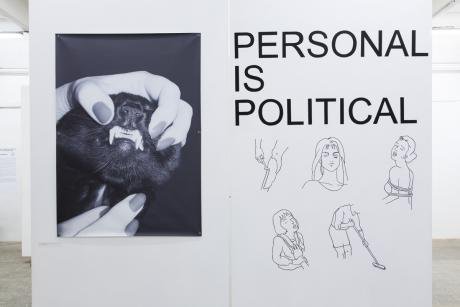
In her project Alesya Zhitkevich (Minsk) reflects on a classic feminist essay by Carol Hanisch. ‘Personal is Political’, 2013-2014. (c) Sergei Zhdanovich.
Reproductive labour is also important. The Ukrainian artists Ksenia Gnilitskaya and Alina Yakubenko created a video called ‘The Lifelong Game’ in 2015: the work imitates a videogame, in which a woman, occupied with everyday household chores, earns points and bonuses for each completed stage. The ‘game’ reflects the lives of many women in post-Soviet countries, but sadly, in real life, women’s reproductive work is endless and any points that the woman accrues are illusory, as they cannot be converted into money or social status.
The endless cycle of reproductive labour is often explored by artists with a mixture of seriousness and humour. For example, Mikaela from Moscow analyses the ‘ritual of an ironed shirt’ in her Anthropological Reconstruction (2014) with scientific rigour; Anna Zvyagintseva from Kyiv makes a Catalogue of Women’s Labour (2013), and Ukrainian artist Alevtina Kakhidze creates her texts and drawings about domestic labour at the same time as she performs the tasks which she depicts (In Order to Clean More Quickly, 2013).
While we can trace common themes in some artworks, feminist art in post-Soviet countries is not limited to a narrow circle of ideas. In fact, it is often intersectional, turning to the experiences of various marginalised groups.
For instance, a graphic art series by Viktoria Lomasko captures moments from different lives: of Russian sex workers, of lesbian women, of anti-authoritarian protests’ participants. The artist Hagra from Russia raises the issues of classism and transphobia in her comic work, and paints the life within and beyond the gender binary framework. Alina Kopytsia from Ukraine, in her drawings, fabric collages and sculptures, explores BDSM and exhibitionism, tracing the connection between the sexual and social. While taking an action against conservative attacks, feminist art also reflects on the society, offering it new visions and perspectives.
The art of survival
Feminist art in Belarus, Russia, and Ukraine is a way of life, but those who engage in it often must master an art of survival. Although more and more male and female artists are addressing gender questions in their work, such a topic is not accorded the prestige and status of more conventional artistic mores, particularly when it positions itself as feminist.
In 2014, I took a friend of mine to an exhibition at the prestigious Pinchuk Art Centre gallery in the centre of Kyiv. I was overjoyed to see the same collage which Zhanna Kadyrova had created for the ‘Women’s Workshop’ exhibition in 2012. I started to explain the feminist undercurrent of this work to my companion, only to be cut short by the description of the artwork on the wall provided by the curator. Any mention of gender had disappeared completely and the work was described as addressing the ‘globalisation of mediatised images’. In 2014, after the Maidan protests, the same work was described as a ‘symbol of the protests which are flowing all over the world.’ In other words, the very same processes which feminist artists explore and criticise in their work can function in the discourse of galleries and curators so as to deprive art works of an explicitly feminist or polemical orientation.
Telling is the reception of Anna Zvyagintseva’s iron sculpture Fragment. Although it was called ‘a monument to women’s work’ by its author, the media and galleries maintain a stubborn silence with regard to its intended subject matter, and generalize the work as merely addressing ‘labour as such’ and the ‘mundane nature of life.’

Anna Zvyagintseva: 'The movement to bring together feminist artists must simultaneously exist in institutional and activist realms and create connections between the two. Perhaps it should even create its own activist institution.' ‘Fragment’ installation, 2013. (c) Anna Zvyagintseva.
Sometimes this silence passes over into censorship. In 2013, the curators of an exhibition called ‘International Women’s Day. Feminism: from avant-garde to the present day’, excluded a work by Viktoria Lomasko due to its referencing the Pussy Riot group. It is not surprising therefore that feminist artists often prefer to organise and display their work on their own and maintain autonomous projects. Even though they can receive token support in the form of grants or free exhibition space from friendly organisations and curators, these artists rarely receive any payment, and work merely due to their commitment to their ideas.
In post-Soviet countries, feminist art frequently exists in a space between galleries and the streets. As street artists, Mikaela, Smart Mary (Umnaia Masha), and the groups Gandhi and Zoa art all predominantly work on the street. They use the streets to create political art, directing society’s attention to social problems, and remind viewers of the historical traditions of feminism.
Although such art is soon destroyed and painted over, it is perhaps the most accessible to the general public. Many artists in Russia and Ukraine are also activists in political social movements, and readily create posters and stickers, which are used at feminist actions. Banners and posters by Smart Mary appear both at various demonstrations and in gallery spaces as art objects.
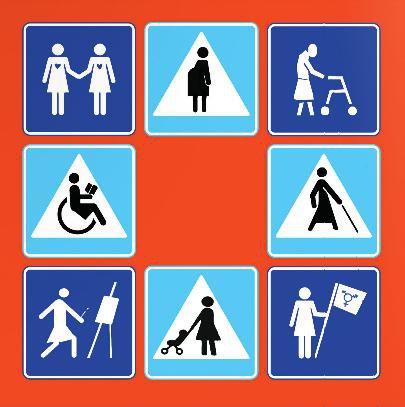
Smart Mary (Moscow): 'I believe that in order to achieve civic victory, we have to recognise our individual weaknesses and to speak out about them. The cult of strength and purity leads only to fascism and segregation.' ‘On-Off’ poster, 2013 (c) Smart Mary.
Although feminists must survive in these conditions, their work can directly help others to survive. A recent example is a performance of the Vagina Monologues in St Petersburg in 2014 (curated by Leda Garina and Anastasia Khodyreva). The money raised by the performance gathered funds for a women’s crisis centre that provides support for victims of people trafficking as well as victims of domestic and sexual violence.
At a time when Russian state support for crisis centres is almost zero, the money raised by ticket sales contributed to enabling a telephone hotline, which female victims can call and receive support. Similarly, a performance of the Vagina Monologues in Kyiv (organised by the Positive Women group and curated by Galina Dzhykaieva, Galya Yarmanova, and Lesia Pagulich) helped gather funds for a women’s crisis centre in Donetsk in order to aid women in the Donbas conflict zone.
Feminism without borders
Despite their working in various formats, some feminist artists from Ukraine, Belarus, and Russia often meet and share their experiences. At the end of 2014, the new platform Feminist (Art) Criticism arose in Minsk. The curators Irina Solomatina and Tatsiana Shchurko gathered together feminist artists and researchers from 11 countries. For two weeks the project became a hub of academic and creative activity, providing exhibitions, concerts, master classes and conferences.
Despite many official obstacles, a new generation of feminist artists has appeared in Russia.
In Russia, the socially engaged project Feminist Pencil was created in 2012. Organised by Nadia Plungian and Viktoriya Lomasko, the project led to a few exhibitions and the establishment of an international separatist feminist art movement. The female artists of the Feminist Pencil revived the somewhat forgotten art of graphics and political posters.
The bravery of the statements and the ‘sharpness’ of the artists’ pencils are aimed at destroying stereotypes and exposing society’s many double standards. The project’s success inspired new feminist art initiatives, and clearly demonstrated that, despite many official obstacles, a new generation of feminist artists has appeared in Russia.
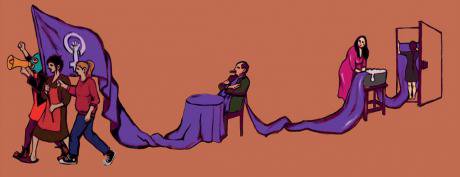
Artivist Mannaya Kasha (Moscow-Novosibirsk): ‘For me, feminist art is a fight against hierarchy. The weapon is a multi-tool with a double edge: it's not just aimed at women viewers, but also functions as an instrument of unceasing self-analysis for the artists themselves.’ 'Feminist banner’ street sticker, 2012-2013 (c) Mannaya Kasha.
Amongst those international feminist art projects in Ukraine, it is important to note the most recent, Motherhood, in 2015. With the developing war and economic crisis, Ukrainian society finds itself on the threshold of yet another conservative turn, and one which is based on crude nationalist rhetoric: men are praised as heroes whilst women and marginalised groups are forgotten. Curated by Oksana Briukhovetska, the project Motherhood addressed this problem through an exhibition, film screenings, lectures, and public discussions. It seems that many feminist artists would agree with the remarks Motherhood participant Joanna Rajkowska: ‘I do not perceive reality as a permanent state of affairs, which I must endure with pain. The way we arrange our own world and our co-existence in it depends on us – the residents of this building, city, country, world…’
In its direct movement towards equality, feminist art in Belarus, Russia, and Ukraine supersedes personal and state boundaries. It inspires protest, and its protest gives us inspiration in return.
Read more
Get our weekly email
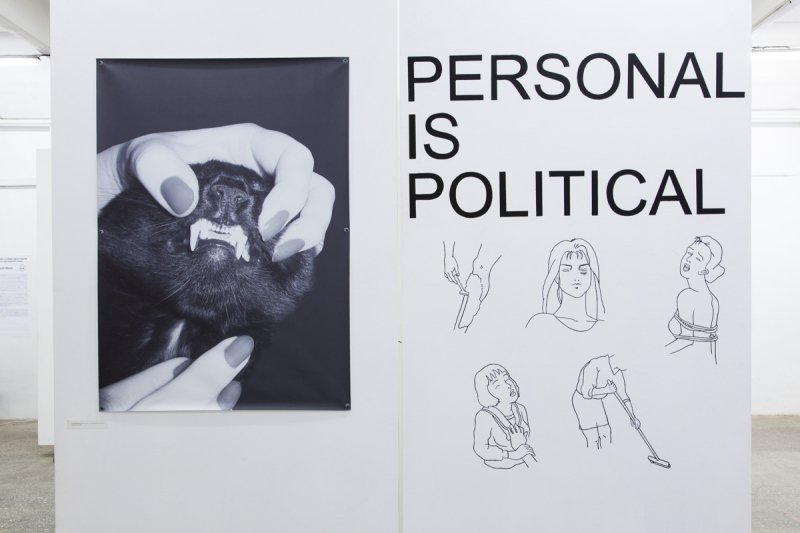
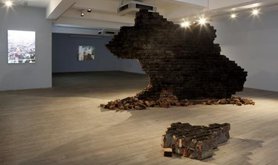

Comments
We encourage anyone to comment, please consult the oD commenting guidelines if you have any questions.